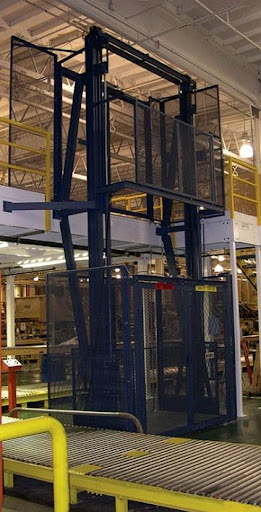Growing Your Square Footage
Adding a mezzanine to your facility can provide you with extra square footage and storage space, sometimes doubling your useable space.
Once you’ve added a mezzanine to your facility, you have many choices as to how to lift and lower materials to this level, including forklifts, scissor lifts, elevators, or manually moving via stairs. While manually moving materials and using these other traditional material lifting methods gets the job done, they are not the safest or most cost-effective way to do so.
What Is a Mezzanine Lift?
1. Space optimization: Mezzanine lifts are designed to maximize vertical space utilization. They are typically installed in the corner or against a wall, allowing for minimal floor space usage while providing access to the mezzanine level. This is particularly beneficial in areas where floor space is limited or valuable.
2. Customization: Mezzanine lifts can be customized to your specific material lifting application, whether your lifting needs are limited, require unlimited cycle use, or need to be part of an automated conveyor system.
3. Versatility: Mezzanine lifts can accommodate a wide range of materials, from small items to large and heavy loads, allowing for flexibility in transporting different types of materials or equipment to the mezzanine level.

5. Time efficiency: Mezzanine lifts provide a quicker and more efficient means of transporting materials to the mezzanine level. Instead of relying on manual labor or traditional material handling equipment like forklifts or pallet jacks, a mezzanine lift offers a streamlined process for moving materials vertically, saving time and effort.
6. Convenience and ease of use: Mezzanine lift systems are designed for user-friendly operation. They often feature simple controls, allowing operators to load and unload materials with ease. This makes them accessible to a broader range of personnel, reducing the reliance on specialized equipment or skills.
7. Cost-effectiveness: Mezzanine lifts are less expensive to install and maintain than conventional elevators, and the long-term maintenance cost savings and efficiencies realized compared to other material handling equipment such as forklifts, can be significant. Material lift elevators can increase productivity and efficiency, reducing labor costs associated with manual material handling. Additionally, they can minimize the risk of product damage or accidents, potentially saving money on repairs or medical expenses.
Read More: British Retailer Optimizes Warehouse Utilization with Pflow VRC
Lift Your Productivity with a PFlow VRC
At PFlow, we take tremendous pride in the safety, performance, and durability of our industry-leading vertical reciprocating conveyors (VRCs), and we strive to deliver outstanding customer service and after-sales parts and service support.
Our VRCs offer unmatched safety and efficiency and are designed to meet your specific material size, space, and lifting requirements. Click below to learn more about how PFlow’s VRC experts and knowledgeable material-handling dealer network can work with you to design, install, and operate equipment that will serve your needs today and for years to come.
